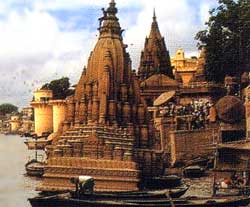Important Places of Pilgrimage
Varanasi

The Ganges at Varanasi, the city closely connected to Lord Shiva
Perhaps the most famous of all holy places is Varanasi, situated on the banks of the Ganges some 450 miles south of Delhi. It is also called Benares and Kashi. It may be one of the oldest cities in the world and is included in the list of India’s “seven ancient cities.” It is mentioned in the Epics and Puranas as “the foremost city of Shiva.” Its most famous mandir, the Golden Temple dedicated to Visvanatha (Shiva), was destroyed and then rebuilt under Muslim rule.
Many Hindus retire to Varanasi in the hope of achieving liberation. The city is famous for its cremation ghats. Corpses are transported hundreds of miles for burning here. Relatives often bring the ashes of their loved ones and scatter them in the Ganges in the belief that this will benefit the departed soul.
Mathura and Vrindavana

The town of Vrindavan particularly dear to the Gaudiya (Bengali) Vaishnavas who worship Radha and Krishna. This is one of their seven principal and historical temples.
Mathura, another ancient city of India, lies 95 miles south of Delhi. It is most famous as the place of Krishna’s birth, which tradition dates to some five thousand years ago. Its main temple is the Keshava Deo Mandir, where Radha and Krishna are worshipped. The entire area, encompassing many holy sites and twelve sacred forests, is called Vraj. Most important is Vrindavan, the village where Krishna lived. It is now a bustling town with some five thousand temples, mostly dedicated to Krishna. Many elderly Vaishnavas retire to this sacred town in the hope of returning at death to the spiritual Vrindavan, where they can engage in eternal lila (pastimes) with their Lord.
Kanyakumari
Kanyakumari, one of the most important Shakta holy sites, is situated on the southernmost tip of India. The main temple is dedicated to Parvati, the eternal consort of Shiva. At the Bay of Bengal, where the Arabian and Indian occeans meet, many pilgrims come to bathe. On the beach there are seven different colours of sand, apparently transformed from the seven colours of rice thrown in celebration when the Goddess married Lord Shiva at this spot.
Puri
The Smartas are the fourth largest Hindu tradition, after the worshippers of Vishnu, Shiva and Shakti respectively. Most members of this community follow Shankaracharya (788–820 CE), who established four main “maths” (seats) in the “four dhamas,” the four holiest places in India. The current Shankaracharya resides in the main seat at Puri, in the state of Orissa on the east coast. The city is also central to Vaishnavas for its 900-year-old temple of Jagannatha, the Lord of the Universe, who is served by 6,000 priests. It is also famous for the annual Ratha-yatra (chariot festival), attended by thousands of pilgrims. Replica Ratha-yatras are also celebrated annually throughout the world.
Special Places
- Rivers (especially confluences) and lakes
- Hills and mountains
- Sites associated with particular deities (often with shrines and murtis there)
- Places connected with gurus, saints, and other religious leaders
- Towns and villages mentioned in sacred stories
- Places considered to be replicas or or gateways to, the higher realms
- Places where holy people congregate
